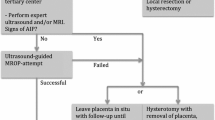Abstract
The general approach to placentas delivered after 23 weeks was outlined in the previous section and only a few points of emphasis pertaining to findings most relevant to adverse outcomes in late preterm and term placentas will be mentioned here. The first is the identification of an umbilical cord at risk for interrupted fetoplacental blood flow. Relevant findings include abnormal cord insertion (see below), deformations due to entanglements or prolapse, excessive cord length, hypercoiling, and true umbilical cord knots. The second is documentation of green discoloration of the membranes, chorionic plate, and sometimes the surface of the umbilical cord. Usually due to meconium staining, this finding should prompt histologic evaluation for the duration of meconium exposure. Finally, identification of excessively pale and/or edematous parenchyma that can accompany massive fetomaternal hemorrhage with or without superimposed hydrops fetalis.
Access this chapter
Tax calculation will be finalised at checkout
Purchases are for personal use only
Similar content being viewed by others
References
Chisholm KM, Heerema-McKenney A. Fetal thrombotic vasculopathy: significance in liveborn children using proposed society for pediatric pathology diagnostic criteria. Am J Surg Pathol. 2014;39:274–80.
Redline RW. Cerebral palsy in term infants: a clinicopathologic analysis of 158 medicolegal case reviews. Pediatr Dev Pathol. 2008;11:456–64.
Redline RW. Clinical and pathological umbilical cord abnormalities in fetal thrombotic vasculopathy. Hum Pathol. 2004;35:1494–8.
Redline RW, Ravishankar S. Fetal vascular malperfusion, an update. APMIS. 2018;126:561–9.
Altshuler G, Russell P. The human placental villitides: a review of chronic intrauterine infection. Curr Top Pathol. 1975;60:63–112.
Redline RW. Villitis of unknown etiology: noninfectious chronic villitis in the placenta. Hum Pathol. 2007;38:1439–46.
Kim MJ, Romero R, Kim CJ, et al. Villitis of unknown etiology is associated with a distinct pattern of chemokine up-regulation in the feto-maternal and placental compartments: implications for conjoint maternal allograft rejection and maternal anti-fetal graft-versus-host disease. J Immunol. 2009;182:3919–27.
Myerson D, Parkin RK, Benirschke K, et al. The pathogenesis of villitis of unknown etiology: analysis with a new conjoint immunohistochemistry-in situ hybridization procedure to identify specific maternal and fetal cells. Pediatr Dev Pathol. 2006;9:257–65.
PrabhuDas M, Bonney E, Caron K, et al. Immune mechanisms at the maternal-fetal interface: perspectives and challenges. Nat Immunol. 2015;16:328–34.
Khong TY, Mooney EE, Ariel I, et al. Sampling and definitions of placental lesions: Amsterdam Placental Workshop Group Consensus Statement. Arch Pathol Lab Med. 2016;140:698–713.
Redline R. Distal villous immaturity. Diagn Histopathol. 2012;18(5):189–94.
Stallmach T, Hebisch G, Meier K, et al. Rescue by birth: defective placental maturation and late fetal mortality. Obstet Gynecol. 2001;97:505–9.
Ogino S, Redline RW. Villous capillary lesions of the placenta: distinctions between chorangioma, chorangiomatosis, and chorangiosis. Hum Pathol. 2000;31:945–54.
Bagby C, Redline RW. Multifocal chorangiomatosis. Pediatr Dev Pathol. 2010;14:38–44.
Benirschke K. Recent trends in chorangiomas, especially those of multiple and recurrent chorangiomas. Pediat Devel Pathol. 1999;2:264–9.
Soma H, Watanabe Y, Hata T. Chorangiosis and chorangioma in three cohorts of placentas from Nepal, Tibet and Japan. Reprod Fertil Devel. 1996;7:1533–8.
Amer HZ, Heller DS. Chorangioma and related vascular lesions of the placenta--a review. Fetal Pediatr Pathol. 2010;29:199–206.
Gallot D, Marceau G, Laurichesse-Delmas H, et al. The changes in angiogenic gene expression in recurrent multiple chorioangiomas. Fetal Diagn Ther. 2007;22:161–8.
Jauniaux E, Nicolaides KH, Hustin J. Perinatal features associated with placental mesenchymal dysplasia. Placenta. 1997;18:701–6.
Faye-Petersen OM, Kapur RP. Placental mesenchymal dysplasia. Surg Pathol Clin. 2013;6:127–51.
Pham T, Steele J, Stayboldt C, et al. Placental mesenchymal dysplasia is associated with high rates of intrauterine growth restriction and fetal demise: a report of 11 new cases and a review of the literature. Am J Clin Pathol. 2006;126:67–78.
Kaiser-Rogers KA, McFadden DE, Livasy CA, et al. Androgenetic/biparental mosaicism causes placental mesenchymal dysplasia. J Med Genet. 2006;43:187–92.
Armes JE, McGown I, Williams M, et al. The placenta in Beckwith-Wiedemann syndrome: genotype-phenotype associations, excessive extravillous trophoblast and placental mesenchymal dysplasia. Pathology. 2012;44:519–27.
de Almeida V, Bowman JM. Massive fetomaternal hemorrhage: Manitoba experience. Obstet Gynecol. 1994;83:323–8.
Swank ML, Garite TJ, Maurel K, et al. Vasa previa: diagnosis and management. Am J Obstet Gynecol. 2016;215:223 e1–6.
Ichinose M, Takemura T, Andoh K, et al. Pathological analysis of umbilical cord ulceration associated with fetal duodenal and jejunal atresia. Placenta. 2010;31:1015–8.
Altshuler G, Arizawa M, Molnar-Nadasdy G. Meconium-induced umbilical cord vascular necrosis and ulceration: a potential link between the placenta and poor pregnancy outcome. Obstet Gynecol. 1992;79:760–6.
Laube DW, Schauberger CW. Fetomaternal bleeding as a cause for ‘unexplained’ fetal death. Obstet Gynecol. 1982;60:649–51.
Biankin SA, Arbuckle SM, Graf NS. Autopsy findings in a series of five cases of fetomaternal haemorrhages. Pathology. 2003;35:319–24.
King EL, Redline RW, Smith SD, et al. Myocytes of chorionic vessels from placentas with meconium associated vascular necrosis exhibit apoptotic markers. Hum Pathol. 2004;35:412–7.
Redline RW. Meconium associated vascular necrosis. Pathol Case Rev. 2010;15(3):55–7.
Redline RW. Severe fetal placental vascular lesions in term infants with neurologic impairment. Am J Obstet Gynecol. 2005;192:452–7.
Author information
Authors and Affiliations
Corresponding author
Editor information
Editors and Affiliations
Rights and permissions
Copyright information
© 2021 Springer Nature Switzerland AG
About this chapter
Cite this chapter
Redline, R.W., Ravishankar, S. (2021). Late Preterm/Term Placentas (Late Third Trimester: 32–42 Weeks from LMP). In: Martinovic, J. (eds) Practical Manual of Fetal Pathology. Springer, Cham. https://doi.org/10.1007/978-3-030-42492-3_16
Download citation
DOI: https://doi.org/10.1007/978-3-030-42492-3_16
Published:
Publisher Name: Springer, Cham
Print ISBN: 978-3-030-42491-6
Online ISBN: 978-3-030-42492-3
eBook Packages: MedicineMedicine (R0)




